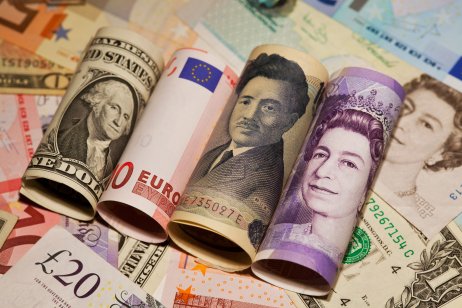

Foreign exchange markets have been volatile following Russia’s invasion of Ukraine. Soaring oil and gas prices and shortage fears have sent ripples through the global economy.
In a recent poll by Reuters, 90% of currency strategists said they expected volatility to either increase or increase significantly in the coming three months.
How are currencies being affected, and which are putting in the weakest performance against the US dollar?
Safety first
Unsurprisingly, the Russian rouble (RUB) has been the hardest-hit currency, losing more than 40% of its value against the dollar since the start of the year amid punishing economic sanctions. On Monday morning the rouble fell to a new record low of 133.5 to the dollar.
Beyond this, analysts point to clear trends.
“Patterns have been emerging in the FX markets, with commodity currencies and safe havens (USD, Japanese Yen (JPY) and Swiss Franc (CHF) performing well and European currencies under pressure,” Jane Foley, head of FX Strategy at Rabobank, told Capital.com.
The currencies of commodity-exporting countries located far from the war in Eastern Europe include the Australian (AUD) and New Zealand (NZD) dollars, the Colombian peso (COP) and the Brazilian real (BRL). It’s “a stark departure from previous bouts of risk aversion,” said Ebury senior market analyst Matthew Ryan, when emerging market currencies tend to sell off.
But those under pressure include:
What is your sentiment on USD/TRY?
Vote to see Traders sentiment!
The euro (EUR)
The EU’s single currency has fallen 4.8% against the dollar over the past month, according to data from investing.com, reaching its lowest level since May 2020.
“EUR/USD has been free-falling in response to Russia’s invasion of Ukraine, and for good reasons,” Yohay Elam, currency analyst at FXStreet, told Capital.com.
“The eurozone is heavily dependent on imports of Russian energy. Some 40% of the bloc’s gas comes from Russia with an even higher dependency in Germany, the continent’s locomotive. The cost of fueling cars and heating homes may become crippling, swinging the eurozone into recession.”
Elam also pointed to the divergence in monetary policy between the US and the Eurozone.
Federal Reserve (Fed) Chair Jerome Powell has committed to raising interest rates to combat inflation, with a recent Reuters poll forecasting at least 125 basis points of tightening by the end of the year. What action will be taken by the European Central Bank, which meets on Thursday, is more uncertain.
“The longer the war rages, the lower EUR/USD could fall, with 1.0650 and 1.05 serving as the next significant downside targets,” Elam added.
Other European currencies
Countries outside of the euro have certainly not been exempt from the shift to safe havens, with Eastern European currencies like the Hungarian forint and Polish zloty falling on concerns over their geographical location and energy links with Russia.
The Swedish krona (SEK) is down 8.8% over the month, with Sweden’s Riksbank sticking to a similarly dovish stance. The Danish krone (DKK), which is pegged to the euro, is down 4.8%.
Looking forward, Elam notes: “The Danish krone is set to struggle more than the Swedish krona, as Denmark, a NATO member, already plans to phase out imports of Russian oil. Sweden is sticking to its historic neutral stance and will likely refrain from taking significant action to anger Moscow.
“While both currencies will likely appreciate against the euro – while depreciating against the dollar – the Swedish krona has a relative advantage over its neighbour.”
Continuing hawkish signals from the Bank of England gave the pound (GBP) a relatively decent performance over the last week, “somewhere in between the US dollar and the euro, and ris[ing] against every other European currency,” said Ebury’s Matthew Ryan.
Further afield
Currencies exposed to the crisis further afield include the Indian rupee (INR), which is down 3% over the month, and the Mexican peso (MXN), down 2.5%.
“While emerging market countries that export commodities are experiencing a reprieve, currencies such as the INR are under pressure given India’s huge dependence on imported energy,” said Foley.
The Turkish lira (TRY), meanwhile, is down 5.5% against the dollar over the month.
It has seen a month of relative stability after a chaotic December when the currency dropped to a record low on interest rate cuts, before jumping 47% in what a Financial Times report said indicated central bank intervention through its foreign currency reserves.
Monday saw the lira weaken by 1% against the dollar, as Turkey faces down 54% inflation and a widening current account deficit.



